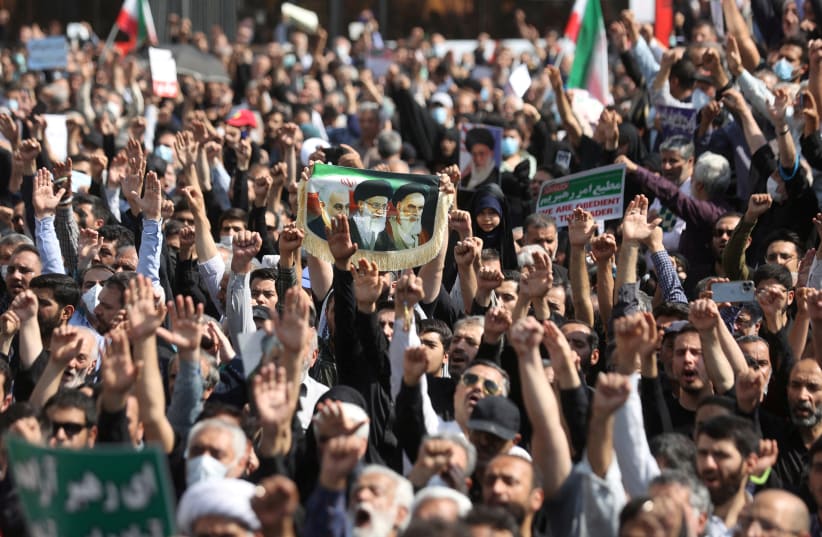The Iranian regime launched repeated attacks on Iraq on Wednesday, increasing the number of groups and people it is targeting. Tehran has used artillery, drones and rockets to attack the region over the past several days, according to local reports.
There are fears that Iran could launch a ground operation – an unlikely scenario, but one that nevertheless illustrates its feeling of impunity in attacking Kurds.
Ostensibly, the Iranian regime claims to be targeting “terrorist” groups, but it has expanded the number of groups and areas it is attacking. It has attacked the Kurdistan Democratic Party of Iran (KDPI), as well as Komala and the Kurdistan Freedom Party, or PAK, over the past several days.
“Dozens of Iranian explosive-laden drones targeted the positions of the Kurdish opposition parties in Iraq’s Kurdistan Region early on Wednesday,” the Kurdistan24 news channel reported, citing Iran’s military.
This appears to be a major operation, as Iran is using kamikaze-style drones. Iran has also exported Shahed-136 drones to Russia, though it is unclear if Tehran is using the same drones to attack Kurdish groups.
“The Kurdistan Democratic Party of Iran headquarters in the Koya district was similarly targeted by dozens of suicide drones,” Kurdistan24 reported. “The residential compounds of the party were attacked as well, Mohammad Nazif Qadiri, a senior party official, said.”
The headquarters of the Sulaymaniyah-based Komala Party of Iranian Kurdistan was hit by similar attacks on Wednesday, its commander told Kurdistan 24. In addition, six members of the PAK were killed by a drone and missile attack south of Erbil.
This is thought to be the reason that there are fears of Iranian attacks on Perde, a town that lies between Erbil and Kirkuk. Iranian-backed Shi’ite militias operate near Kirkuk, the site of clashes in 2017, when the Iraqi government sought to force Kurdish forces to leave the city.
The US has condemned the attacks, saying in response to a question from Kurdistan24: “We condemn violations of Iraqi sovereignty and territorial integrity, including the reported shelling by Iran’s forces in the Iraqi Kurdistan Region.”
This has not deterred Iran, however. Attacks continued to occur against KDPI throughout Wednesday afternoon. According to local residents, a pregnant woman was killed in the IRGC missile attack on Koy Sanjaq, and further casualties were expected.
Iran has attacked this area several times, including a missile attack in 2018 and other smaller attacks over the past few years, and it has targeted Erbil with rockets and drones. The impunity that Iran believes it enjoys is clear. Pro-Iranian groups in Iraq have also targeted Erbil International Airport. There have been attacks on gas and energy facilities near Kalak and also on the road from Sulaymaniyah to Kirkuk.
The Islamic Republic has shown over the past few years that it feels it can attack US forces in Iraq’s autonomous Kurdistan Region, as well as Kurdish opposition and dissident groups.
The larger context of this is clear. Iran is exporting drones to Russia, the same kind it uses to terrorize the Kurdish Region and the same kind it wants to export to groups in Iraq, Syria and Yemen to threaten the Gulf and to threaten Israel and US forces in Syria. Iran has already attempted drone attacks against the Jewish state, such as in February 2018, May 2021 and earlier this year. These attacks have expanded to include drones flown from Iran.
Iran has also claimed to target the “Mossad” in northern Iraq, linking its war on Kurdish groups with its conflict with Israel. This means that Tehran is now using the protests as a pretext to launch more attacks in the Kurdistan Region, and it is seeking to neutralize or destroy a plethora of Kurdish resistance groups, including KDPI, Komala and PAK. It may even increase the attacks to target PJAK, a Left-leaning Kurdish group.
Iran’s use of missiles, drones and artillery illustrates not only its new way of war, using precision drone and missile attacks, but also its sense of impunity that it can strike in Iraq, close to centers of power in Erbil, and destabilize the region. Iran knows that the Kurdistan Region is among the most wealthy and stable in Iraq and that it is close to US forces’ facilities.
The Kurdish Peshmerga, the armed forces of the autonomous region, receives support from the US and the West. They have attempted to unify and reform their units, strengthening the region. Iran wants the region divided and weak. Its attacks are meant to show that the Kurdistan Region cannot defend itself. Many Kurds from Iran fled to Iraq to enjoy the freedom and opportunities it offers.
Iran appears to be purposely terrorizing civilians now in the Kurdistan Region. Videos that were published on Wednesday afternoon showed terrified children and parents. The regime seems to be indicating that if it cannot crush protests at home, it will use its power to attack random people in Iraq.
There are a number of Kurdish opposition groups from Iran that have supporters and bases in the Kurdistan Region of Iraq. Their houses and camps are usually spread out and quite small and modest. Iran has threatened to target these areas for years and likely knows the location of many of these groups and their supporters.
It has also been sending agents to the Kurdistan Region for years, keeping tabs on the opposition and also engaging in assassinations and other types of attacks. This is well known to Iranians who live in northern Iraq, especially among Kurds. They know that Iran has tried to infiltrate their communities and spy on them.
Opposition groups also know that Iran has threatened and carried out attacks, and it is clear that Wednesday’s attacks are an escalation of some sort. The number of missiles and drones used and the many locations that were targeted point to an expanding conflict and Tehran’s attempt to stamp out these groups in one fell swoop.
